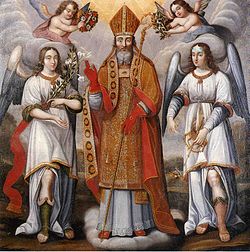Deodatus of Nevers
- View a machine-translated version of the German article.
- Machine translation, like DeepL or Google Translate, is a useful starting point for translations, but translators must revise errors as necessary and confirm that the translation is accurate, rather than simply copy-pasting machine-translated text into the English Wikipedia.
- Do not translate text that appears unreliable or low-quality. If possible, verify the text with references provided in the foreign-language article.
- You must provide copyright attribution in the edit summary accompanying your translation by providing an interlanguage link to the source of your translation. A model attribution edit summary is
Content in this edit is translated from the existing German Wikipedia article at [[:de:Deodatus von St. Dié]]; see its history for attribution. - You may also add the template
{{Translated|de|Deodatus von St. Dié}}to the talk page. - For more guidance, see Wikipedia:Translation.
Saint Deodatus of Nevers | |
|---|---|
 The Glorification of Deodatus | |
| Born | possibly Ireland |
| Died | 679 AD |
| Venerated in | Eastern Orthodox Church Roman Catholic Church |
| Canonized | 1049 by Pope Leo IX |
| Feast | June 19 |
| Attributes | depicted with hand stretching to thunder clouds[1][2] |
| Patronage | invoked for rain, and against thunderstorm, evil spirits, and plague |
Deodatus (Dié, Didier, Dieudonné, Déodat, Adéodat) of Nevers (d. June 19, ca. 679 AD) was a bishop of Nevers from 655.
Exploits
Deodatus was born about 590 to an illustrious family of western France. In 655 Deodatus was appointed bishop of Nevers. He attended the Council of Sens in 657.[3]
In 664 he resigned his see, having recommended to his clergy the choice of a successor. He made the acquaintance of Saints Arbogast and Florentius and walked the mountain passes to the Forest of Haguenau where he led an eremitical life.[3] He baptized the son of Saint Hunna (Una), who was also named Deodatus and who is also venerated as a saint. Hunna's son became a monk at Ebersheim.
Later he retired deeper into the Vosges. Hun, lord of the Val de Galilee, bestowed on him some territory, which donation was confirmed by King Childeric II. There he established the monastery Juncturae (Jointures). He placed Jointures under the Rule of Saint Columban (later changed to that of Saint Benedict).[4]
Tradition states that he died in the arms of Saint Hidulphus, bishop of Treves.[3]
Veneration
The town of Saint-Dié grew up around the monastery of Jointures. However, some sources connect the name with an earlier saint, Deodatus of Blois (d. 525).[5]
He is invoked as the patron saint for rain, and against thunderstorms, evil spirits, and plague.[6]
-
 Relicary of Deodatus of Nevers
Relicary of Deodatus of Nevers -
 The Consecration of Deodatus
The Consecration of Deodatus
References
- ^ Husenbeth, Frederick Charles. Emblems of Saints: By which They are Distinguished in Works of Art, Longman, Green, Longman, and Roberts, 1860, p. 45
- ^ Drake, Maurice and Drake, Wilfred. Saints and Their Emblems, T. W. Laurie Limited, 1916, p. 34
- ^ a b c O'Hanlon, John. Lives of the Irish saints, Vol. 6, 1873, p. 739
- ^ Butler, Alban. The Lives of the Saints. Vol. VI: June. 1866
- ^ "Saint Patrick's Church: Saints of April 24". Archived from the original on 2007-02-06. Retrieved 2012-02-22.
- ^ "Saint Deodatus of Nevers", Cnews Live, June 18, 2023
External links
- (in German) "Deodatus of Nevers". Biographisch-Bibliographisches Kirchenlexikon (BBKL) (in German).
- (in German) Deodatus (Dieudonné, Dié) von St. Dié
- (in Norwegian) Den hellige Deodatus av Nevers














